
The 2024 United States National Defense Strategy – The High Cost of Rebuilding the American Military Machine
The Commission on the National Defense Strategy for the United States recently released its final report to Congress and the President of the United States (whoever they may be) and some of the conclusions are eye-opening.
Here is the cover page of the 2024 edition of the National Defense Strategy report:
The authors of the report found that, among the senior civilian and military leaders of the Department of Defense and other departments; congressional leaders from relevant committees; private sector representatives; former government officials; experts in the think tank, academic, and federally funded research and development centre communities; and foreign allies that they met with, there was “near-unanimous recognition of the significant challenges to U.S. national security and broad agreement on the need for substantial and wide-ranging change” and that the national security system was outdated, bureaucratic and too political to make the changes that are necessary to protect America’s role as global “police force” quickly enough. There is also a reliance on decades-old military equipment and a culture of risk avoidance that is handicapping the U.S. military’s ability to maintain its current role in the current unipolar world that is under threat from two growing superpowers.
The report opens by observing that both China and Russia are the major powers that seek to undermine U.S. global interest and that, in many ways, China is outpacing the United States and has negated America’s military advantage in the Western Pacific over the past two decades. In both cases, the report states that military spending by the superpowers-in-waiting is rising; in 2024, Russia is estimated to spend 35 percent of its federal budget or 7.1 percent of its GDP on national defense and China announced a 7.2 percent increase in its official defense spending bringing it to 1.6 percent of GDP (excluding very significant off-budget items). This compares to roughly 3 percent or 12 percent of government spending for the United States. As well, China and Russia’s “no limits” partnership formed in February 2022 along with the joint military and economic partnership with Iran and North Korea presents a growing threat to U.S. interests.
The report goes on to note that all-out war with a peer or near peer would be devastating for several reasons:
1.) massive military and personnel costs which is problematic given that recent recruitment shortfalls have resulted in decreased size of the Army, Air Force and Navy.
2.) risk of cyberattacks on America’s critical infrastructure.
3.) global economic recession due to disruptions to supply chains, manufacturing and trade.
4.) denied access to critical minerals needed to run the American economy and build weapons systems.
5.) hold U.S. space assets at risk.
Here is a quote with my bolds:
“The U.S. public are largely unaware of the dangers the United States faces or the costs (financial and otherwise) required to adequately prepare. They do not appreciate the strength of China and its partnerships or the ramifications to daily life if a conflict were to erupt. They are not anticipating disruptions to their power, water, or access to all the goods on which they rely. They have not internalized the costs of the United States losing its position as a world superpower. A bipartisan “call to arms” is urgently needed so that the United States can make the major changes and significant investments now rather than wait for the next Pearl Harbor or 9/11. The support and resolve of the American public are indispensable.“
The authors of the report recommend that the U.S. Joint Force be structured to simultaneously:
1.) defend the homeland, maintain strategic deterrence, prevent mass casualty terrorist attacks, maintain global posture, and respond to small-scale, short-duration crises.
2.) lead the effort, with meaningful allied contribution, to deter China from territorial aggression in the Western Pacific—and fight and win if needed
3.) lead NATO planning and force structure to deter and, if necessary, defeat Russian aggression
4.) sustain capabilities, along with U.S. partners in the Middle East, to defend against Iranian malign activities.
As I noted above, the authors have taken notice of the decreased ability of the U.S. military to recruit new personnel which you can clearly see on this graphic from RealClear Defense:
Here is another quote from the Commission’s report that is rather sobering for young Americans (with my bold):
“Redoubled recruiting efforts, new incentives for service, and more flexible personnel systems are needed to offset a lack of propensity for and interest in military service among the eligible population. Military retention remains high, demonstrating that personnel in service largely choose to remain in uniform. The nation must also consider the possibility that future conflict could overwhelm the capacity of the active-duty force and should plan now to better prepare the reserve components and, potentially, a broader mobilization. More broadly, we support calls for increased levels of public and civil service to help provide a renewed sense of engagement and patriotism among the American people.“
Get ready for a full-fledged, Vietnam War-style draft which, as one might expect, will not impact the offspring of the ruling class.
Of course, the recommended solution to the problem is a greater level of funding. According to the report, Department of Defense spending ranged from 4.9 percent to 16.9 percent of GDP during the Cold War as shown here:
Keep the 4.9 percent to 16.9 percent of GDP numbers in mind. During the Cold War, it is important to remember that DoD spending relied on top personal marginal income tax rates of 70 percent and corporate tax rates averaging 50 percent. As such, the Commission makes the following recommendations:
1.) DoD should immediately review all major systems against likely future needs, emphasizing battlefield utility and prioritizing agility, interoperability, and survivability. DoD should invest more in cyber, space, and software, which have enabled warfighting for decades but are now central to conflict and have global reach.
2.) Congress should pass a supplemental appropriation immediately to begin a multiyear investment in the national security innovation and industrial base. Funding should support U.S. allies at war; expand industrial capacity, including infrastructure for shipbuilding and the ability to surge munitions production; increase and accelerate military construction to expand and harden facilities in Asia; secure access to critical minerals; and invest in a digital and industrial workforce.
3.) DoD should immediately begin making structural changes and prioritization adjustments to spend national security funds more effectively and more efficiently. DoD should address its recruitment challenges, rewrite regulations to speed defense procurement (and address cultural impediments and risk aversion), and shift the R&D paradigm to adopt technological innovation from outside the department for warfighting purposes. The U.S. government should review national security authorities for agencies other than DoD and look for ways to enable and facilitate information-sharing, coproduction, and export controls to better work with allies.
4.) Congress should revoke or override the caps in the 2023 Fiscal Responsibility Act that serve as the basis for the FY 2025 budget request.
a.) For FY 2025, real growth in defense and nondefense national security spending is needed and, at a bare minimum, should fall within the range recommended by the 2018 NDS Commission. Increased spending should be allocated to emphasize near-term readiness demands to restore and reinforce deterrence.
Here is a graphic showing the budgetary shortfall when compared to the 2018 NDS Commission:
b.) Given the severity of the threats, the FY 2027 and later budgets for all elements of national power will require spending that puts defense and other components of national security on a glide path to support efforts commensurate with the U.S. national effort seen during the Cold War.
c.) Larger amounts of defense spending should be accompanied by sufficient resources to build capacity at the departments of State, Commerce, and Treasury; intelligence, trade, and investment agencies; the U.S. Agency for International Development; and the Department of Homeland Security and focus these organizations on national security missions. The United States should continue to provide support to its allies, which it relies on to fight with (or for) it.
d.) The ballooning U.S. deficit (and I might add debt) also poses national security risks.
And, here’s the key to the last recommendation:
“Therefore, increased security spending should be accompanied by additional taxes and reforms to entitlement spending.”
In other words, U.S. taxpayers should get used to the idea of increased taxes and decreases in entitlement spending for things like Medicare/Medicaid and Social Security at the same time as the nation’s military industrial intelligence complex sticks its snout in the seemingly endless trough of taxpayer dollars.
If we look at the budgets for America’s military during the Cold War which ranged from 4.9 percent to 16.9 percent of GDP and use the same percentages with the current GDP of $28.63 trillion (current dollars), the Pentagon’s budget would range from $1.403 trillion to $4.838 trillion. This compares to Fiscal Year 2024 spending of $948.6 billion on defense, $1.2 trillion on Social Security and $1.2 trillion on Medicare.
In closing, you can bet that this list of individuals that testified at the National Defense Strategy Meetings certainly had an impact on the Commission’s recommendations for a larger U.S. military:
When you ask the military and its insiders what they want, it’s highly unlikely that they are going to say “a smaller military” or “peace”, isn’t it? Another Cold War is a wet dream for these men and women not to mention the upper floor, corner office dwellers at the nation’s defense contractors.

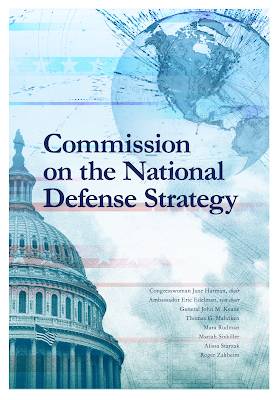
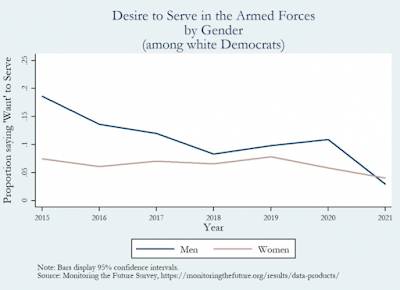
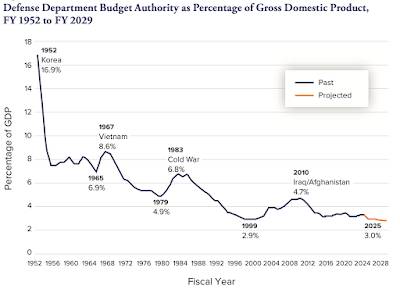
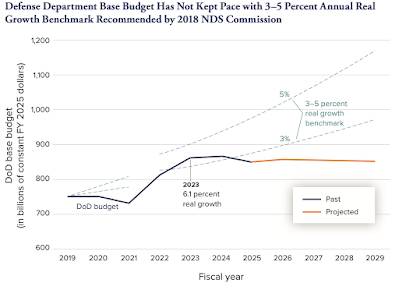

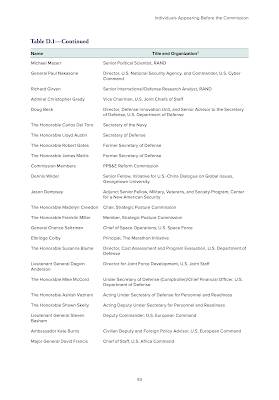
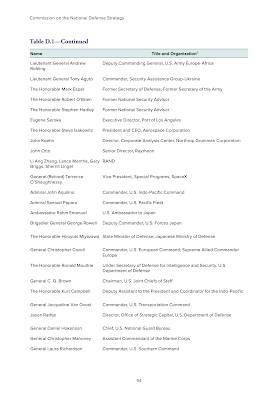
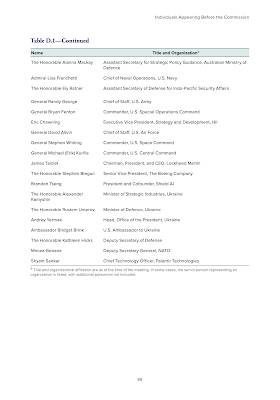
Be the first to comment